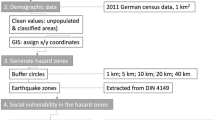Abstract
Based on the case study of Tuymazinsky District in the Republic of Bashkortostan introduced and tested is a methodology for assessing the environmental hazard of industrial enterprises using integral zoning diagrams. Calculations have been carried out and an algorithm for constructing histograms of environmental damage from emergency situations has been developed. Delineation of the groups of industrial enterprises on the criteria of probability of industrial accidents with environmentally hazardous implications and respective cost of damage incurred is substatiated.
Similar content being viewed by others
References
B. N. Porfiryev, “The green factor of innovative modernization of the Russian economy,” Vestn. MGU, Ser. 6: Econ., No. 3, 3–14 (2016) [in Russian].
Methodology for the Integrated Assessment of the Individual Risk of Emergency Situations of Natural and Man-Made Origin (VNII GOChS, Moscow, 2003) [in Russian].
Guidelines for Assessing the Health Risks of the Public when Exposed to Pollutants. P 2.1.10.1920-04 (Fed. tsentr Gossanepidnadzora Minzdrava Rossii, Moscow, 2004) [in Russian].
Methodology “Criteria for Assessing the Ecological Situation in the Territories for Identifying Zones of Emergency Ecological Situations and Zones of Ecological Disasters” (MPR RF, Moscow, 1992) [in Russian].
B. N. Porfiryev, Nature and Economy: Risks of Interaction (Ankil, Moscow, 2011) [in Russian].
B. N. Porfiryev and E. A. Makarova, “Economic assessment of damage from natural disasters and catastrophes,” Vestn. Ross. Akad. Nauk 84 (12), 1059–1072 (2014).
A. S. Tulupov, “The theory of damage as a basis for assessing and regulating negative externalities in environmental insurance,” Doctoral Dissertation in Economics (GUU, Moscow, 2013) [in Russian].
IEC 1025: 1990–Fault tree analysis (FTA, 1990).
Manual of Industrial Hazard Assessment Techniques (1985).
W. R., Munns, Jr. and M. G. Mitro, Assessing Risks to Populations at Superfund and RCRA Sites Characterizing Effects on Populations, EPA/600/R-06/038, ERASC-006 (2006).
B. Porfiriev, “Evaluation of human losses from disasters: The case of the 2010 heat and forest fires in Russia,” Int. J. Disaster Risk Reduct. 7, 91–99 (2014).
D. Vose, Risk Analysis: A Quantitative Guide, 3rd ed. (John Wiley & Son Ltd., Chichester, 2008).
Y. Zhou, et al., “A new approach to ecological risk assessment: Simulating effects of global warming on complex ecological networks,” in Unifying Themes in Complex Systems (2011), pp. 342–350.
B. G. Litvak, Expert Assessments and Decision Making (Patent, Moscow, 1996) [in Russian].
Temporary Typical Methodology for Determining the Economic Efficiency of Implementing Environmental Measures and Assessing Economic Damage Caused to the National Economy by Environmental Pollution (Ekonomika, Moscow, 1986) [in Russian].
Author information
Authors and Affiliations
Corresponding author
Additional information
Original Russian Text © B.N. Porfiryev, A.S. Tulupov, 2017.
Rights and permissions
About this article
Cite this article
Porfiryev, B.N., Tulupov, A.S. Environmental hazard assessment and forecast of economic damage from industrial accidents. Stud. Russ. Econ. Dev. 28, 600–607 (2017). https://doi.org/10.1134/S1075700717060107
Received:
Published:
Issue Date:
DOI: https://doi.org/10.1134/S1075700717060107




